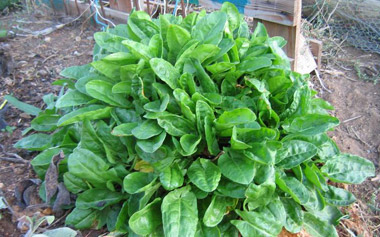Though prized in countries such as Belgium, France and Poland, where bunches of sorrel greens are sold at produce stands and planted in gardens, this hardy perennial green is not well known outside Europe. Sometimes called sour grass, the tart, arrow-shaped leaves, similar in flavor to kiwi fruit, can be added to salads or made into soups and sauces. Sorrel’s delightful tangy flavor and the leaves’ ability to melt or disintegrate makes it a great ingredient in sauces and soups. It is a good complement to fish, chicken, and veal dishes, as well as potatoes and eggs in soups or gratins.
A member of the buckwheat family, sorrel is native to Europe and Asia, and more than 200 varieties grow wild in woodlands and pastures. Wild sheep and field sorrels are small with tiny flowers, but large-leaved garden varieties, such as rumex acetosa (garden sorrel) or rumex scutatus (French sorrel) were domesticated in France during the 1700s.
Egyptians and Romans nibbled on fresh sorrel leaves to soothe the stomach after their elaborate feasts. In medieval Europe, sheep sorrel was used in spring tonics to refresh logy wintry metabolisms, as a garnish for elaborate court dishes, and in tangy sauces. Chef Pierre Francois de la Varenne (1615-1678), an early French culinary writer, made sauces of meat drippings flavored with sorrel.
Medicinally, sorrel was used in earlier times to prevent scurvy, because it is high in vitamin C, and as a fever-reducer or medicine for the plague, cholera and malaria (though its effectiveness is doubtful). Poultices of sorrel have been applied for use in healing wounds, bruises, burns, sores, boils, and acne. Brewed for tea, sorrel has been used to relieve mouth and throat ulcers.
When shopping for sorrel, look for bright green, young leaves with tender stems. Like other greens, it is best when young and tender; older, larger, darker and usually more pointed greens can be slightly bitter. Avoid leaves that are yellow-green or wilted. Although I’ve never seen it in my local supermarkets, it is available at farmers’ markets and at large city markets. If you grow your own, cut the leaves at ground level and break the stems off backwards to eliminate the tough strings which sometimes continue up the center of the leaf. If you cut the flowering stems for arrangements, you’ll continue to get a harvest of tender leaves into early winter.
If you’ve never used sorrel, start by adding a few leaves to a spinach or lettuce salad, add to egg dishes like quiche or omelet, or use a little to garnish and brighten potato, vegetable or cream-based soups, or coool summer soups like vichyssoise. You can also add it to egg, potato, pasta or grain salads. A refreshing iced tea can be made by steeping the leaves in hot water for 10 minutes, then chilling and adding sugar or honey to taste. If you cook it, like most greens, it will cook down quickly, so you need a lot.
Here’s a great dish to try:
Polish Sorrel Soup (Shchav)
There are many variations on this traditional Polish soup that can use either homemade stock or commercial chicken broth.
Ingredients:
2 Tablespoons butter
1 pound fresh sorrel leaves
.5 pound fresh spinach
1 quart chicken-vegetable stock or chicken broth
2 Tablespoons flour
1/3 cup sour cream
Fresh chives
Fresh parsley
Croutons
Directions:
(To make stock, cook chicken thigh with salt, spices, and root vegetables).
Melt butter in Dutch oven. Add sorrel and spinach and cook, stirring, until wilted. (If you want a smoother soup, you can put it through a food processor at this point.) Add broth. Blend sour cream with flour, and stir into soup to thicken. Heat, slowly, stirring. Spoon soup into bowls over chopped hard-cooked egg. Garnish with fresh chopped chives, parsley, and croutons.



